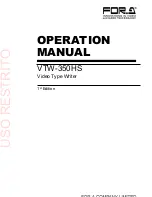
28 | SAMLEX AMERICA INC.
SAMLEX AMERICA INC. | 29
Formula 1 given above may be used to calculate the AC watts. The next step is to
estimate the DC current in Amperes (A) from the AC watts as per Formula 2 above. An
example of this calculation for a 12V inverter is given below:
Let us say that the total AC Watts delivered by the inverter = 1000W.
Then, using Formula 2 above, the approximate DC current to be delivered by the 12V
batteries = 1000W ÷10 = 100 Amperes, or by 24V batteries = 1000W ÷ 20 = 50A.
Next, the energy required by the load in Ampere Hours (Ah) is determined
.
For example, if the load is to operate for 3 hours then as per Formula 3 above, the
energy to be delivered by the 12V batteries = 100 Amperes × 3 Hours = 300 Ampere
Hours (Ah).
Now, the capacity of the batteries is determined based on the run time and
the usable capacity.
From Table 7.3 “Battery Capacity versus Rate of Discharge”, the usable capacity at
3 Hour discharge rate is 60%. Hence, the actual capacity of the 12V batteries to
deliver 300 Ah will be equal to: 300 Ah ÷ 0.6 = 500 Ah.
And finally, the actual desired rated capacity of the batteries is determined
based on
the fact that normally only 80% of the capacity will be available with respect to the
rated capacity due to non availability of ideal and optimum operating and charging
conditions. So the final requirements will be equal to:
FOR 12V BATTERY:
500 Ah ÷ 0.8 = 625 Ah (note that the actual energy required by the load was 300 Ah).
It will be seen from the above that the final rated capacity of the batteries is almost
2 times the energy required by the load in Ah.
Thus, as a Rule of Thumb, the Ah
capacity of the batteries should be twice the energy required by the load in Ah.
7.17 CHARGING BATTERIES
Batteries can be charged by using good quality AC powered battery charger or from alter-
native energy sources like solar panels, wind or hydro systems. Make sure an appropriate
Battery Charge Controller is used. It is recommended that batteries may be charged at
10% to 13% of their Ah capacity (Ah capacity based on C-Rate of 20 Hr Discharge Time).
Also, for complete charging (return of 100% capacity) of Sealed Lead Acid Battery, it is
recommended that a 3 Stage Charger may be used (Constant Current Bulk Charging Stage
}
Constant Voltage Boost / Absorption Charging
}
Constant Voltage Float Charging).
In case, Wet Cell / Flooded Batteries are being used, a 4-stage charger is recommended
(Constant Current Bulk Charging Stage
}
Constant Voltage Boost / Absorption Stage
}
Constant Voltage Equalization Stage
}
Constant Voltage Float Stage).
SECTION 7 |
General Information on
Lead-Acid Batteries
Summary of Contents for PST-1000F-12
Page 55: ...SAMLEX AMERICA INC 55 NOTES ...
















































